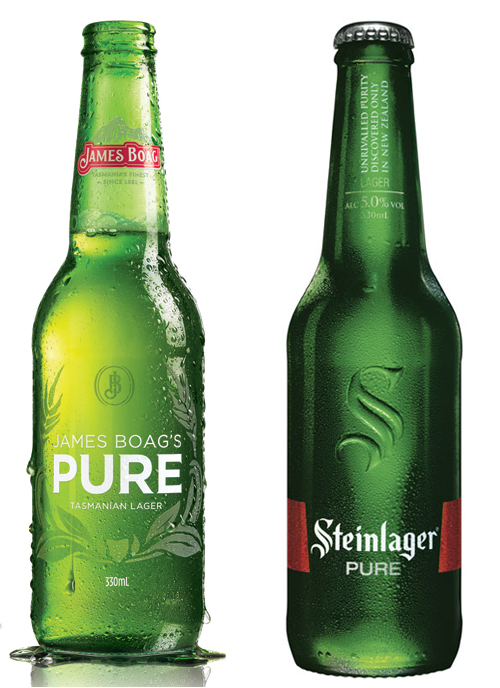
James Boag’s Pure vs Steinlager Pure
James Boag’s (Lion Nathan) Pure Pale lager 330ml 4.5% abv
Steinlager (Lion Nathan) Pure Pale Lager 3330ml 5% abv
This review wasn’t meant to be a Brews News smackdown tasting, it had started as a James Boag’s Pure review. However, when I went to purchase the review bottle I did not look closely enough at the assortment of green, unadorned bottles in the bottleshop fridge and grabbed a bottle of the Steinlager Pure by mistake. With the mistake so easy to make I wondered whether it would matter if I’d bought the wrong one and a smackdown was born.
Upon tasting it was clear the similarities weren’t confined to the bottle. Pouring each into identical tasting glass, it was impossible to tell them apart. Both poured with a dense, white head of fine champagne-like bubbles that dissipated quickly to a thin film. The colour was identical, as was the sweet, heavy and unmistakable scent associated with European premium lagers in green bottles that rose as the containers were uncapped. I guess that one of these reasons Boag’s refers to its beers as ‘ultra premium’ is they actually use hops rather than light stabilised hop extracts. In the case of Boag’s Tasmanian Southern Hallertau are used, while with Steinlager it’s Pacific Jade Hops. All well and good, and—at least in the case of the Steinlager—it adds some complexity to the beer but, if you’re buying either, buy the protection from light that a carton affords.
The young and helpful Liquorland sales assistant who served me noted my joint purchase and expressed a distinct preference for the Boag’s version. “They’re both good, but the Steinlager is much hoppier. I don’t like really hoppy beers,” he explained. He was spot on to the extent that the hop profile of the Steinlager had an ever-so-slightly more crisp, tingly bitterness at the front of the mouth and aftertaste. The Boag’s is a little softer and slightly more rounded at the corners, however it’s a struck match between them and given the .5% difference in alcohol content, not surprising. Certainly, neither fits in the “really hoppy” category and I wonder how the attendant goes with beers like Peroni or Becks, fairly mild lagers but with a comparatively more distinct bitterness than either of these. Based on the releases from the major breweries over the last twelve months, I suspect the sales assistant’s palate is a bell wether for where mainstream beers are headed.
Aside from being slightly light affected, it is impossible to fault either beer for being anything other than bland and uninteresting—though their branding and marketing is designed to convince that the opposite is true. They are not bad beers, just designed for a large market that likes obvious brands and unobtusive flavours.
Both beers are available nationally with a RRP of $57.99 per carton and $17.99 for a six pack.
You’ll probably like these if: You think that breweries get their water from the stream that runs beside the brewery and not a tap like the rest of us.




